Trelleborg
Trelleborg (Swedish pronunciation: [trɛlɛˈbɔrj]) is a town in Skåne, Sweden, with 43,359 inhabitants as of December 31, 2015.[1] It is the southernmost town in Sweden located some 10–15 kilometres (6.2–9.3 mi) west from the southernmost point of Sweden and the Scandinavian peninsula. It is one of the most important ferry towns in Scandinavia as well as around the Baltic Sea, and the main town of the Söderslätt agricultural areas.
Trelleborg | |
|---|---|
.JPG.webp) Trelleborg town hall | |
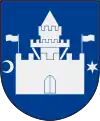 Coat of arms | |
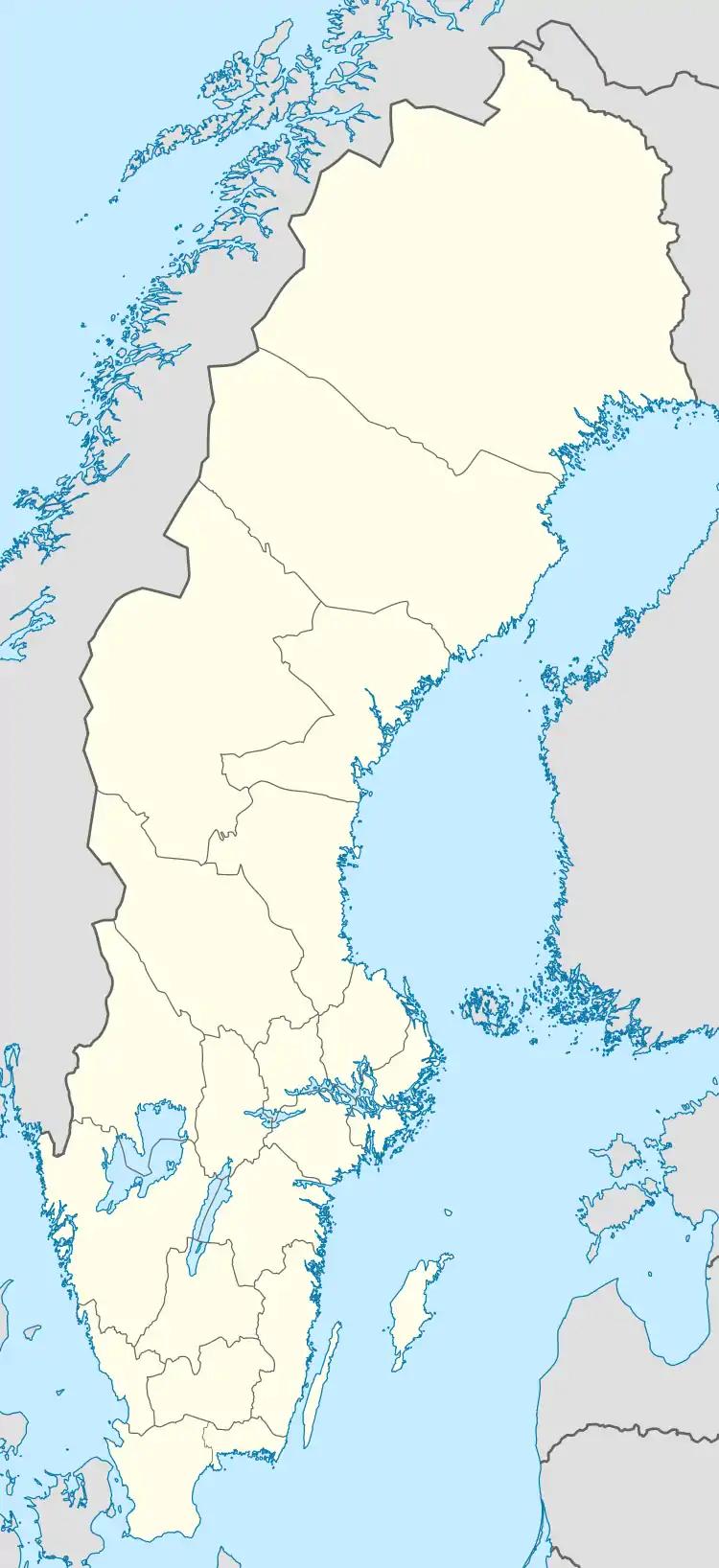 Trelleborg | |
| Coordinates: 55°22′N 13°10′E | |
| Country | Sweden |
| Province | Scania |
| County | Skåne County |
| Municipality | Trelleborg Municipality |
| Area | |
| • Total | 13.66 km2 (5.27 sq mi) |
| Population (31 December 2015)[1] | |
| • Total | 43,359 |
| • Density | 2,071/km2 (5,360/sq mi) |
| Time zone | UTC+1 (CET) |
| • Summer (DST) | UTC+2 (CEST) |
Etymology
The first written record of the name is from 1291, Threlæburgh. The name is found in many places in Scandinavia.[2] Borg means castle or stronghold and träl can mean thrall, but can also refer to the leaning poles on the outside of the medieval Viking stronghold. Remains of the original stronghold were excavated in 1988.
The name may also have originated from the stronghold that still remains in the center of the city. Strongholds like that have been found at several places around Scandinavia, mostly in the south of Sweden and Denmark, and are all called trelleborgs. The name is likely to have originated from that borg.
History
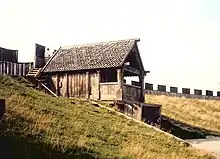
The earliest written record of Trelleborg is from 1257, when Trelleborg was presented as a wedding gift from the Danish royal family to the Swedish Prince Valdemar. It was soon reconquered by the Danes, and it belonged to Denmark until 1658, when Scania was lost to Sweden by the Treaty of Roskilde.
In medieval times, Trelleborg had an important part in herring fishing. At that time, this was conducted along the entire coast line of what is now Sweden, as the herring shoals were of such great numbers that fishermen were said to have been able to stand on the shore and land fish with nets. Trelleborg became an important merchant city as merchants from Germany came to trade herring. In 1619 following a devastating fire, the Danish King decided that one merchant city on the coast was sufficient and revoked Trelleborg's status as a merchant city in favour of Malmö.
Not until 1840 was Trelleborg allowed to become a merchant city, and not until 1867 did it regain its rights as a city of Sweden. Mostly this was thanks to the work of a few stubborn men, who had continuously been petitioning the Swedish Riksdag with these requests since 1658. The local government reform of 1971 made Trelleborg the seat of Trelleborg Municipality, covering both rural and urban areas.
Harbour and ferries
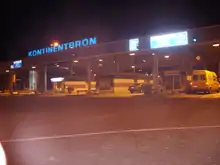
The harbour has a very strategic position, in the very far south of the Scandinavian peninsula. The first ferry connection to Germany opened in 1897.[3] This was replaced with a train-ferry line to Saßnitz, in 1909 as a part of the line Malmö - Berlin.[4] During the GDR era, a longer car ferry line opened to Travemünde ("modern harbour" of Lübeck), initially as line owned by the Swedish national railways (SJ), but known as TT-Line [3] from 1962. After the fall of the Berlin Wall in 1989, several new shipping lines and routes opened. Trelleborg municipality built a joint ferry terminal for all services, known as "Kontinentbron", or "the Continental Bridge". Both Germany and Poland can be reached by ferries from the terminal. As of 2018, the following shipping lines and routes are in operation:
- to Klaipėda (Lithuania)
- to Travemünde (Germany)
- to Rostock (Germany)
- to Swinoujscie (Poland)
- to Swinoujscie (Poland)
Most of the ferry transports are lorries, and this makes Trelleborg's port the largest in Sweden in terms of goods by weight. In 2005, 11 million metric ton of goods passed through the port (along with almost 2 million passengers).[9]
Climate
Although Trelleborg does not have an official month to month weather station featured in SMHI's reports, its nearest weather stations in Falsterbo and Malmö both indicate an oceanic climate (Cfb) with warm and sometimes hot summers averaging in the low twenties Celsius most of the time and cool but generally not very cold winters with means at or just above freezing.
Today
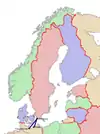
At the end of the 19th century, Trelleborg became an industrial town and the foundation of modern Trelleborg has largely been created by a few large companies; most notably Trelleborg Industries and the ferry company and business related to the seaport. Much of it has been the work of the influential businessman Johan Kock. Other important industries he established were Akzo Nobel Inks, Today called Flint Group Sweden, manufacturing printing inks (established as Gleitzman Industries in the 1890s), and DUX, who make beds. Later in the 1950s, Perstorp (Flooring) Industries was established in Trelleborg and it manufactures flooring boards and other plastic material. Trelleborg continues to be a working-class-oriented city and is politically a traditional stronghold for the Swedish Social Democratic Party. However, since the latest elections in 2006 the Social Democratic Party is in opposition in the municipality.
It is today often visited by people travelling from Sweden to Germany because of the ferries to Rostock, Sassnitz, and Lübeck - Travemünde in Germany. These ferries began sailing on May 1, 1897, with the Sassnitz line; the route to Travemünde was established in 1962, while the line to the former East German city Rostock was inaugurated after the fall of the Berlin Wall in 1989. The ferries carry both passengers on one-day journeys, cars with vacationing families, and heavy trucks on their way through Europe. In April 1917, Lenin arrived with the ferry from Sassnitz to Trelleborg on his way from exile back to Russia to lead the Revolution.
Today Trelleborg has the second largest seaport of Sweden, behind Gothenburg. Every year it transports more than 10 million metric tonnes of cargo.
Overlooking the harbour of Smygehuk near Trelleborg is a statue of a nude woman that was installed in 1930. Actress Uma Thurman's grandmother, the mother of Nena von Schlebrügge, was the model for this statue.[10] The entrance road from west has a row of palm trees, illustrating the southern location of the city. They are moved indoors during winter as they can't tolerate freezing temperatures.
On 12 October 2017, several people were injured in shootings in the town, linked to gang violence.[11][12]
Sports
Football clubs Trelleborgs FF, IFK Trelleborg, and FC Trelleborg are based in the town.
Its basketball team is Trelleborg Basket.
Notable individuals
- Andreas Isaksson - retired football player, played for Trelleborgs FF for two seasons.
- Katrin Stjernfeldt Jammeh - current mayor of Malmö Municipality since 2013, raised in Trelleborg
- Patric Kjellberg - retired ice hockey player
- Björn Kjellman - actor and singer
- Andreas Nilsson - handballer
- Olivia Nordgren - politician
- Amanda Ooms - actress and writer
- Alice Timander - dentist
- Mark Weinberg - former judge of the Court of Appeal of the Supreme Court of Victoria in Victoria, Australia, born in Trelleborg in 1948 and later relocated to the United States before emigrating permanently to Australia in 1958.[13]
Gallery
20th century
 Map of Trelleborg dated 1930
Map of Trelleborg dated 1930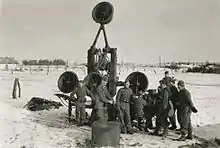 Acoustic air-plane locator stationed in Trelleborg during World War II
Acoustic air-plane locator stationed in Trelleborg during World War II
21st century
 Part of Trelleborg harbour
Part of Trelleborg harbour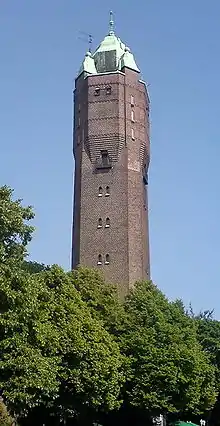
.JPG.webp) Church of St. Nicolai
Church of St. Nicolai Trelleborg Museum
Trelleborg Museum
See also
References
- "Tätorternas landareal, folkmängd och invånare per km2 2005 och 2010" (in Swedish). Statistics Sweden. 14 December 2011. Archived from the original on 10 January 2012. Retrieved 10 January 2012.
- Svenskt ortnamnslexikon 2003
- http://gamlatrelleborg.se/historia-2/hamnen/
- https://www.oppetarkiv.se/video/1810844/journalfilm-svensk-jarnvagstrafik
- "Ferries between Germany, Poland and Sweden - TT-Line". ttline.com. Retrieved 6 August 2015.
- "Färja till Tyskland - Åk bekvämt - Stena Line". stenaline.se. Retrieved 6 August 2015.
- "Stena Line". ferries.se. Retrieved 6 August 2015.
- "Gods- och passagerarfärjor". unityline.se. Retrieved 6 August 2015.
- Nils-Åke Siversson & John Bitton "Öresund ett från himlen", Trafiknostalgiska förlaget, www.trafiknostalgiske.se, ISBN 918530510-3, page 38
- Uma Thurmans mormor staty i Trelleborg Archived 2007-09-26 at the Wayback Machine, Sydsvenskan, 30 July 2006.(in Swedish)
- https://www.telegraph.co.uk/news/2017/10/12/sweden-market-shooting-seven-people-injured-gunman-opens-fire/
- https://www.cp24.com/world/shooting-that-injured-four-in-swedish-town-of-trelleborg-not-terrorism-1.3630250
- https://www.monash.edu/alumni/news/events/graduation/speaker-profiles/justice-mark-weinberg-ao
External links
![]() Media related to Trelleborg at Wikimedia Commons
Media related to Trelleborg at Wikimedia Commons
